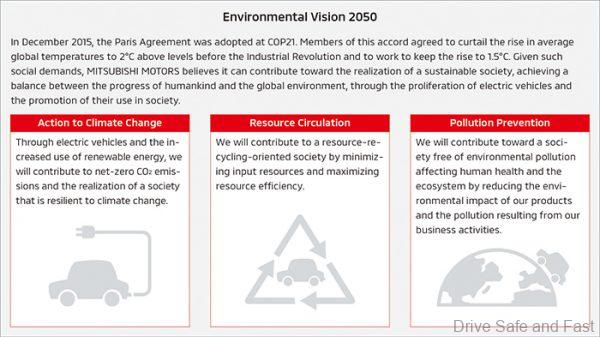The US may have pulled out of the Paris Agreement, but Japan is still fully committed to it. Hence, companies based there are working towards reducing their environmental impact. For Mitsubishi Motors, that involves a long term ‘Environmental Vision 2050’ with key targets to hit by 2030.

So, in 10 years, here are the three things Mitsubishi Motors aims to achieve:
- To reduce the CO2 emissions from new cars by 40 percent compared to FY2010
- To reduce the CO2 emissions from MMC’s business activities by 40 percent compared to FY2014
- To raise the proportion of electric vehicles in the total sales to 50 percent by 2030.
Goal 1 and 3 go hand-in-hand as electric vehicles produce zero CO2 tailpipe emissions. Mitsubishi Motors are no strangers to electric vehicles. They were amongst the first on the scene with a highway-capable EV when they launched the i-MiEV. They’ve also shown strong interest in making electric vehicles based on what they’ve presented at the 2017 and 2019 Tokyo Motor Shows.

However, 10 years is not a lot of time to boost electric car sales by THAT much. Especially when you consider the fact that Mitsubishi Motors have been assigned to lead product development in the South East Asian market. Right now, petrol and diesel power is dominant here, with pick-ups like the Triton and compact crossover MPVs like the XPANDER becoming staple products of Mitsubishi Motors. Will Mitsubishi use rebadged Renault and Nissan EV sales in other markets to reach this 50% EV sales target overall? Or will they push the envelope and bring affordable EVs to South East Asian customers? Time will tell.

PRESS RELEASE
MITSUBISHI MOTORS CORPORATION (MMC) has formulated a new Environmental Plan for the next 30 years. To contribute to realizing a society with net zero carbon dioxide (CO2) emissions in 2050, the company aims for 40 percent reduction in the CO2 emissions from its new cars and business activities, and raising the proportion of electric vehicles in the total sales to 50 percent by 2030. MMC will be fulfilling its responsibility as a manufacturer and seller of automobiles to make ongoing contributions toward a future dynamic, sustainable society. Considering social trends since the adoption of the Paris Agreement, this new Environmental Plan takes a medium- to long-term perspective. The plan is comprised of three parts—MMC’s Environmental Policy, which was revised to incorporate a medium- to long-term outlook; Environmental Vision 2050, which defines the vision of society and the direction of MMC’s initiatives toward 2050; and Environmental Targets 2030, which set out specific targets to achieve by 2030 in order to realize the vision.
1. Environmental Policy
Revised MMC’s Environmental Policy enacted in 1999 to incorporate a medium- to long-term perspective.
2. Environmental Vision 2050
Defines the vision of society of 2050 in terms of climate change, recycling resources, and preventing environmental pollution, and the outlook of related initiatives. Placing the highest priority on measures to combat climate change, this vision aims to contribute to realizing a society with net zero CO2 emissions by 2050.
3. Environmental Targets 2030
MMC has set out specific targets for the next 10 years for its efforts to combat climate change and help realize a society with net zero CO2 emissions by 2050. These are to reduce the CO2 emissions from new cars by 40 percent compared to FY2010, reduce the CO2 emissions from MMC’s business activities by 40 percent compared to FY2014, and raising the proportion of electric vehicles in the total sales to 50 percent by 2030.
Based on this new Environmental Plan, MMC will continue to bolster its eco-friendly technologies leveraging its plug-in hybrid electric vehicles. At the same time, MMC continues to contribute to creating a dynamic, sustainable society by bringing viable products and technologies to more people throughout the world.